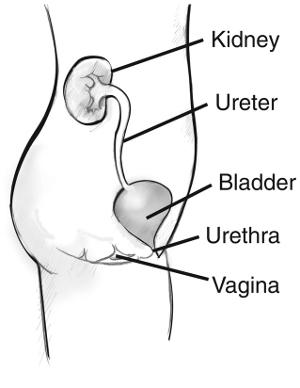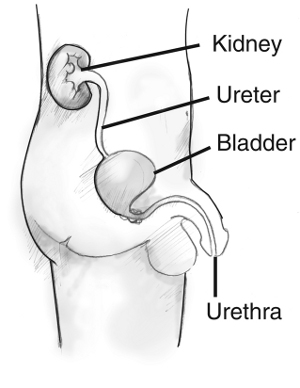The urethra is the passageway between the bladder and the external part of the body, which allows urine to be excreted from the body.
Anatomy
The urethra is a thin, fibromuscular tube that begins at the lower opening of the bladder and extends through the pelvic and urogenital diaphragms to the outside of the body, called the external urethral orifice. The urethra also connects the to the ductus deferens in males, for the ejaculation of sperm. There is a sphincter at the upper end of the urethra, which serves to close the passage and keep the urine inside the bladder.
As the passage needs to traverse the length of the penis, it is significantly longer in males than females. It is approximately 4 cm in length for females, whereas it is about 20 cm in the male body.
The male urethra consists of three parts:
- Prostatic part descends through the prostate and can dilate to change significantly in size
- Membranous part exists between the prostate and the beginning of the penis and is the section targeted if a catheter needs to be inserted
- Spongy part traverses the penis to end at the external urethral orifice



Physiology
The physiological function of the ureter is to allow the passage of urine to outside the body for excretion. When the receptors in the bladder sense that it is full, a response pathway occurs to allow the sphincter to open and the urine to pass into the urethra. This process involves both voluntary and involuntary controls, which allows individuals to dictate when they urinate unless the bladder becomes overfilled when it may occur spontaneously.
The urethra serves an additional purpose in men, as it is also utilized as a passageway for semen when a man ejaculates. Similarly, this involves a complex pathway that releases the semen from the ductus deferens for ejaculation.
Gender Differences
As mentioned previously, there are several differences in the urethra between men and women. These include:
- The length of the urethra is much shorter in women than in men, due to the anatomical gender differences in the area. In males, it extends approximately 20 cm as it must traverse the length of penis, whereas it is only 4 cm in length in females
- The urethra serves a double purpose in men as it also serves as a passage for semen during ejaculation when partaking in sexual activities.
Possible Complications
In some circumstances, the urethra may be affected by certain factors that cause abnormalities in the area. Complications that involve the urethra that may occur include:
- Urinary tract infection – most UTIs occur as a result of bacteria moving up through the urethra and into the bladder where the infection spreads. This occurs more commonly in females, due to the shorter length of the urethra that the bacteria must traverse.
- Urethral strictures – this involves the narrowing of the urethra due to scar tissue in the area. It can occur due to injection or injury to the area, such as the passing of kidney stones through the urethra.
- Urethral cancer – cells in the urethra may develop unusual characteristics that affect they way they replicate and lead to cancer growth.
References
- http://www.medicinenet.com/urethral_stricture/article.htm
- https://www.dartmouth.edu/~humananatomy/part_6/chapter_33.html
- http://www.healthline.com/human-body-maps/female-urethra
- http://patient.info/health/urethral-stricture-leaflet
Further Reading
- All Urethra Content
- Hypospadias outcomes
- Hypospadias
- Hypospadias Research
Last Updated: Jun 28, 2019

Written by
Susan Chow
Susan holds a Ph.D in cell and molecular biology from Dartmouth College in the United States and is also a certified editor in the life sciences (ELS). She worked in a diabetes research lab for many years before becoming a medical and scientific writer. Susan loves to write about all aspects of science and medicine but is particularly passionate about sharing advances in cancer therapies. Outside of work, Susan enjoys reading, spending time at the lake, and watching her sons play sports.
Source: Read Full Article
